Bounds, Bottlenecks, and Digital Marketing
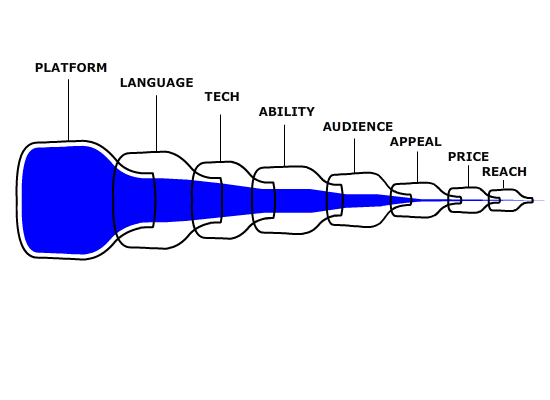
This article's inspiration brought to you by my acquaintance Worthless Bums:
I promise you one thing: you are not anywhere near market saturation for your tiny indie game. Your problem is the exact opposite – you haven’t got anywhere near the sets of eyeballs to glaze over your game. Now there is a cost to getting more eyeballs on your game, and if your potential market is too small this can mean it’s not cost effective to try and market more.
Aside: Early on when I was developing Steam Marines many people (other developers!) remarked on my amazing incompetence for trying to make a commercial roguelike. These days commercial roguelikes are thriving and those sorts of people now call me a sellout. What-the-fuck-ever.
But as Simon Roth says, it’s way cheaper to market a game a bit more than to make a whole new game. Also, you can probably use the practice.
Maybe you've heard of the terms "CPU bound" and "GPU bound". Dwarf Fortress is a great example of a CPU-bound game; it takes no time at all to render the game's graphics (it's just ASCII), but it takes a lot of time (no seriously, a lot of time) to run the simulation.
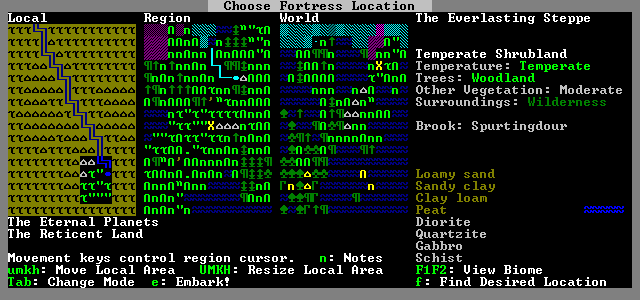
Dwarf Fortress: CPU-bound
This means that trying to speed up Dwarf Fortress by optimizing the graphics code is utterly pointless. Even if you speed up rendering by double, triple, or a thousand times, it won't matter since the CPU is the bottleneck on everything. On the other hand, a typical AAA 3D shooter is GPU bound -- the core game logic (CPU) runs more than fast enough to meet the framerate deadline; it's the rendering (GPU) that's taking too long and causing you to drop frames.
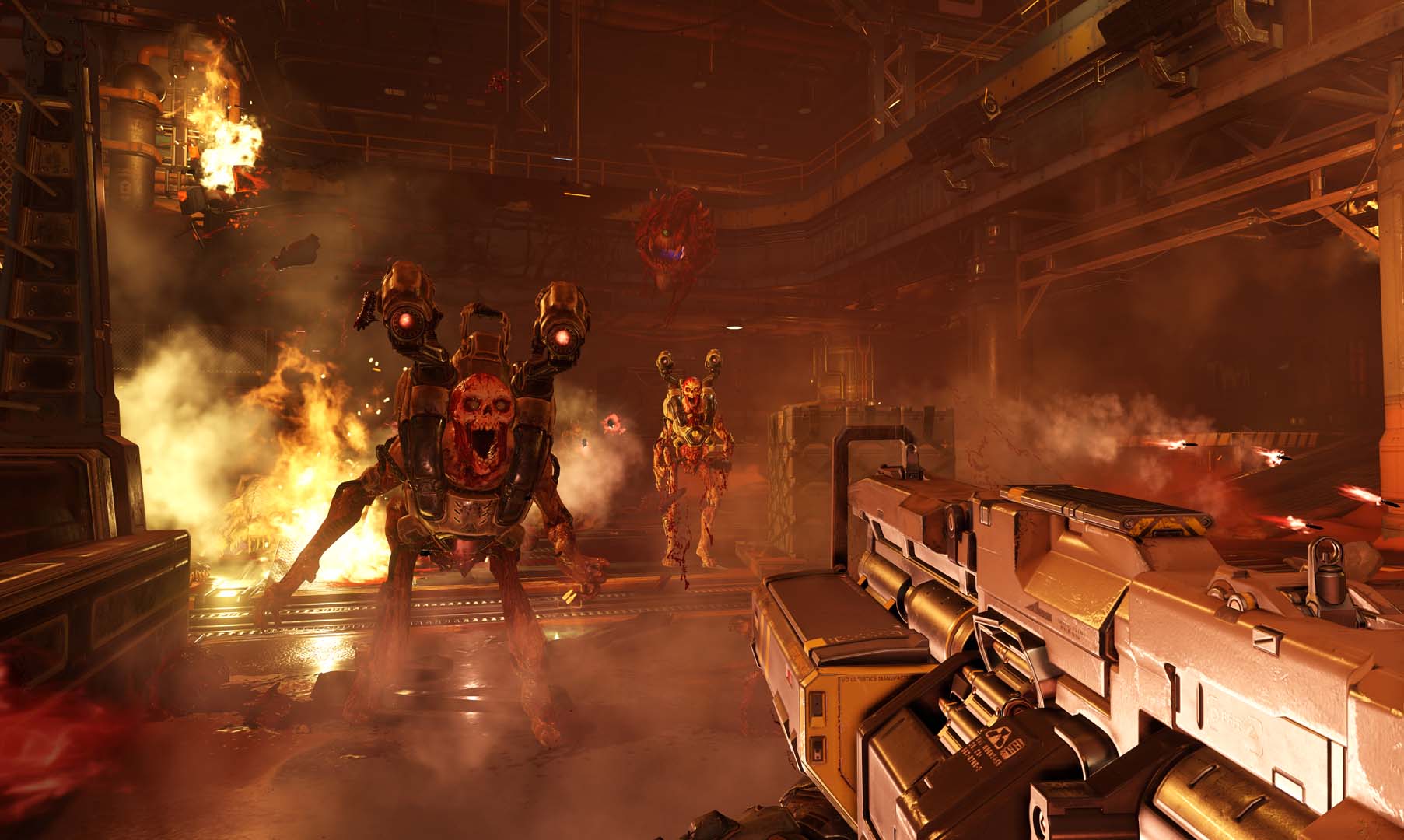
DOOM: GPU bound*
*Note to pedants: Yes, I know modern 3D games can just as easily be CPU bound and it varies highly with setup, but give a man his metaphor, won't ya?
I think marketing is like this. Imagine total potential success as water flowing through progressively smaller bottlenecks.
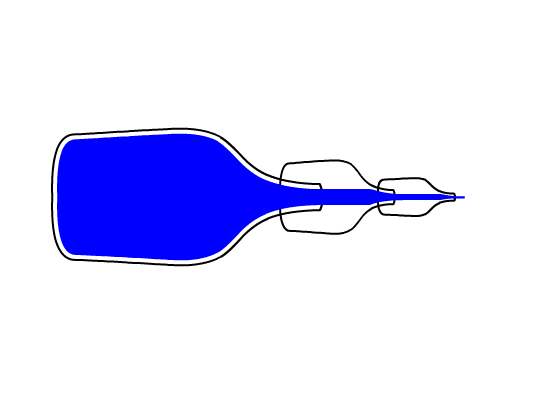
Here the stream is limited primarily by the third bottleneck, the narrowest. To increase the total flow you have to expand the last mouth:
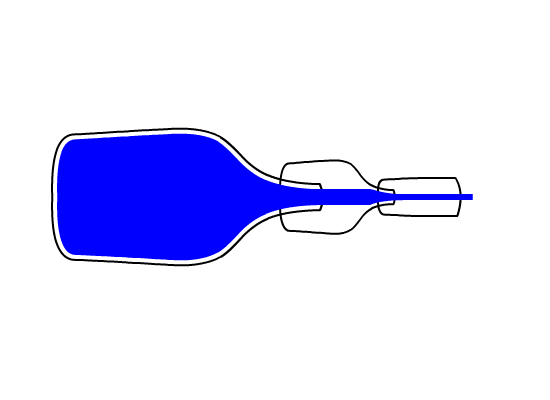
Wow! Look how much wider that third bottle is now! But the stream only increased a little, because now we're limited by the second bottleneck. Let's crack it open, too:
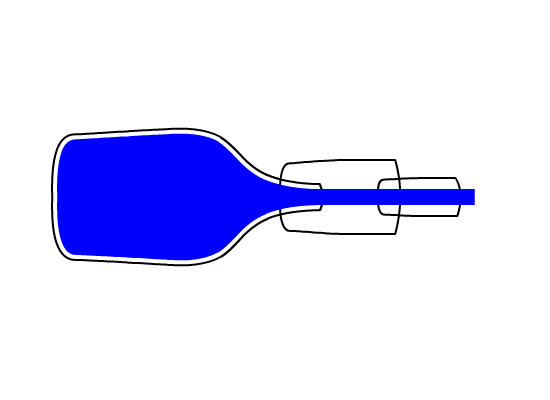
Much better. Now neither the second or third bottleneck limits the whole system, and opening the first bottle will increase the stream even further. But we'll quickly be bound by the third bottleneck again. And back and forth we go until we've done everything we can.
Now, what if our bottles were arranged differently?
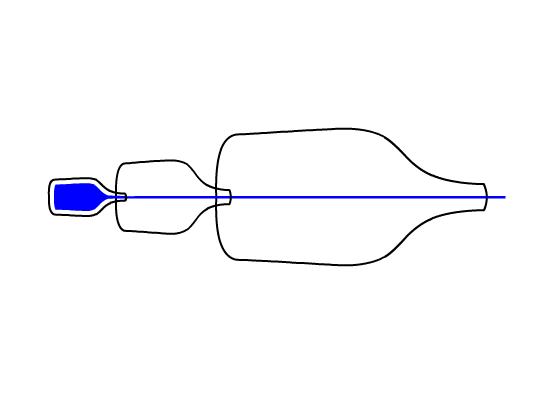
The size of the flow in this perverse scenario is actually the same as in the very first example -- the overall stream is limited by the size of the smallest bottle. However, now we have much less room to grow. Widening the second and third mouths would give us no gains at all until we attack the first bottle.
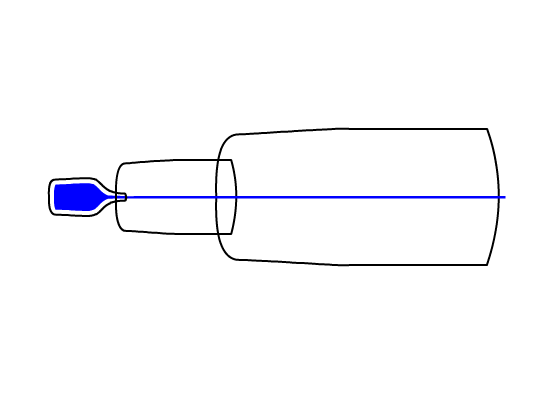
And even if we opened that all the way, its overall volume is so scant that even expanding the second and third bottlenecks will give us only marginal improvement.
So it's important to understand not just which bottlenecks are limiting us, but also how they're arranged. This tells us our overall chances for success and what, if anything, we can do about it.
Okay, let's go from general to specific. What are the bottlenecks in our particular situation and what can be done about them?
I'm in the business of making and selling Indie games, specifically Defender's Quest. I can identify the following bottlenecks on success in the games business, which I'll group into "hard" and "soft" categories.
Hard
- Platform
- Language
- Tech
- Ability
Soft
- Audience
- Appeal
- Price
- Reach
The "Hard" bottlenecks
Platform, Language, Tech, and Ability are four more or less objective filters that narrow your game's total potential customers down from "all humans" to "humans with compatible physical skills and technical resources."
Platform: Only players who can run the game on their device will buy it. It's pretty easy to release on Mac/Win/Linux these days, and consoles and mobile represent good expansion opportunities.
Language: Only players who can understand the game will buy it. This doesn't mean they all have to understand the game's language perfectly, they just need to know enough to play. Most of you probably wouldn't buy a game that was only available in Chinese, for instance.
Tech: If a game is buggy or unstable that will turn people off. Furthermore, some people insist on certain technical features (controller support, 4K resolution, etc), or are filtered out by high system requirements.
Ability: Players tend to avoid games that they totally suck at, or are literally impossible for them to play. This is where that sometimes controversial word "accessibility" comes in. My philosophy is to think clearly about what you want the game experience to be, stand by that proudly, and then aggressively remove all arbitrary obstacles to that experience. If you want a tough-as-nails Souls-like game, that's great, fly that flag. But maybe ditch that extraneous music puzzle -- or else you're needlessly filtering out everyone who's tone deaf.
(For my specific approach to accessibility and difficulty in Defender's Quest, see RPG's, Challenge and Grinding.)
Incidentally, here's what the four "hard" bottlenecks have to say about why I'm not going to jump on the VR train just yet:
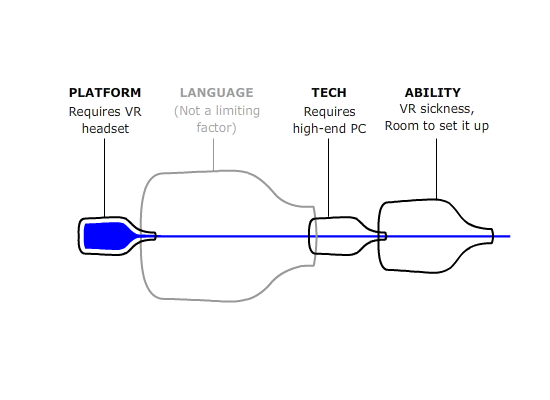
Quick aside: "bottleneck" is not a perfect metaphor. In the real world these bottlenecks can sometimes act more like multipliers rather than hard caps, but the comparison is still useful. And obviously, the particular bottlenecks I identify here, and the order in which I arrange them, is highly debatable.
The "Soft" bottlenecks
The "soft" bottlenecks are a bit more subjective and flexible.
Audience: This is how many humans exist who like your kind of game and might buy it under ideal circumstances. There is some finite number of people who are into rigorously authentic submarine simulators, some maximum number who are into RPG's, shooters, etc.
Genre has a lot to do with this but isn't the only factor. Defender's Quest is a good example: it's a Tower Defense/RPG hybrid, and we've found it appeals to fans of both genres. It could have gone the other way, appealing only to people who are both RPG and Tower Defense fans, which would have been a disaster.
Appeal: Whenever some cool kid says "Just make a good game, and people will buy it," they're actually talking about this bottleneck. This statement is actually true -- the mistake is to take it in isolation. If you put an awesome, appealing game in front of people who are capable of playing it, interested in playing it, and attracted to it, and you make a solid pitch with a positive value proposition, then yes, they'll probably buy it. But you have to do all of that stuff, not just "make a good game".
Price: Nowadays it's easy to change your price or go on sale, so I put price towards the end of the list. Some people will love your game so much they pay full price, while others will wait for a sale. Some live in rich countries and have plenty of disposable income, others don't. If you're primarily selling to people in North America, Europe, and Japan, paid games can work quite well. If you're targeting countries like Brazil, Turkey, and China, you might consider the Free 2 Play model.
Reach: This bottleneck is what most people think of as "marketing." (I would argue attacking all the bottlenecks is what really constitutes "marketing"). Of all the things that have limited your success so far, this is the final pinch on the stream. Take all the humans in the world who have the right system to run your game, understand its language, meet the technical and physical requirements, aren't turned off by the basic design, are attracted to its specific concept, and who can afford to pay for it... and now take that lovely but dwindled figure and crush it under the weight of an oppressive meteor labeled "have actually heard of it."
So once we've passed through every single gate, we're left with a bottle chart that looks like this:
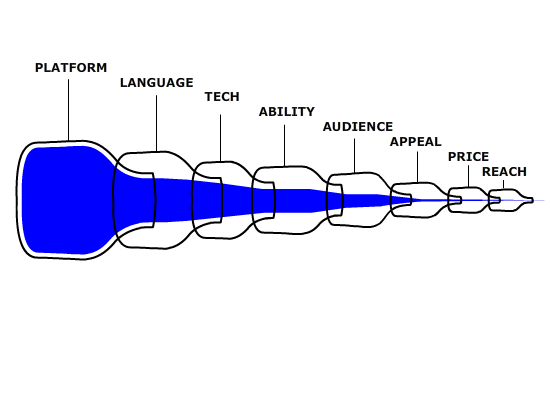
Honestly that's not super bad. A healthy bottle chart going from large to small indicates that you're not wasting efforts on the wrong bottleneck, and you can proceed to open them up from right to left, which should give you improvement with each mouth you widen.
Now let's consider some other scenarios.
Example 1: The oppressively hard, buggy mess:
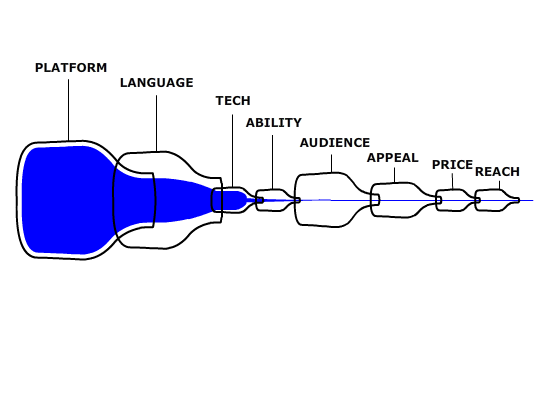
Here's a hypothetical game where "marketing" (in the sense of advertising and reaching out to press, youtubers, etc.) isn't going to help much. The game's overall success is tightly constrained by deep-seated technical issues. Even once those are resolved, its design is so insular, demanding, and difficult (in a bad way) that only a very small number of people have the ability to play it all, even though there's a fairly large number of people who might otherwise like this sort of game.
Something like this maybe:
Example 2: The burned out popular genre:
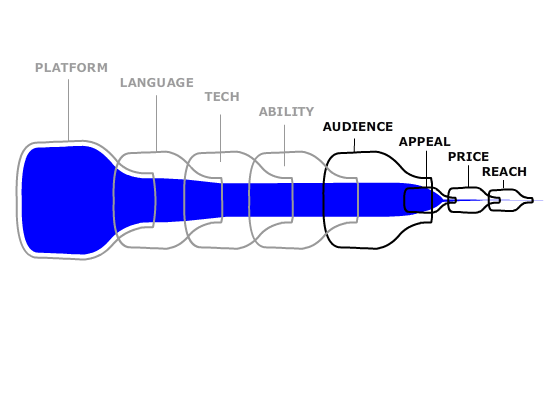
Here we have a really promising start -- a clear path towards a really, really, popular genre. But for whatever reason, nobody finds our specific game appealing even though they really like this kind of game. This is the death trap that every game that tried to compete with World of Warcraft ran into. Everyone loves this kind of game, but nobody wants yours.
Example 3: That game everyone talked about but nobody played:
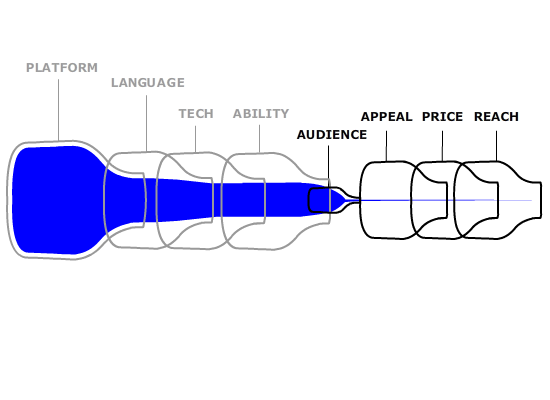
We've all seen the heart-breaking stories of games that win award after award, get talked up and down by the press, it's super innovative and ground-breaking... but nobody seems to have actually bought the dang thing. What gives?
It turns out that's it's possible to be too good at marketing, at least relative to, and at the expense of, all the other success factors. In this case there's simply no getting around the fact that there's only so many people who want to play this kind of game, and it doesn't matter how polished it is (appeal), or how good the pitch is (reach).
Putting it together for Defender's Quest
Over the last four years, here's what I think Defender's Quest's bottle chart looked like:
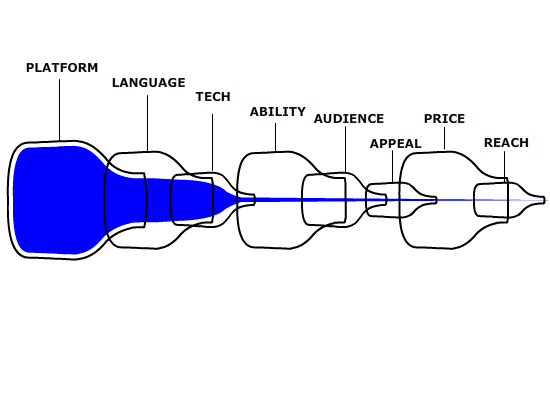
Primarily our game was hampered by two things -- technical issues and unappealing presentation. There were various technical issues, but chief among them was being locked to 800x600, a resolution low enough to be considered "low-res" and unattractive to HD gamers, but still high enough to make clean upscaling difficult or impossible, thus limiting its appeal to the retro crowd -- we discussed this in doing an HD remake the right way.
Furthermore, our art style was a hodge-podge of incremental upgrades, with cutscene art that was widely criticized. Plenty of people are fond of the style to be sure (which is why the DX version lets you play with the old art), but we've seen a clear pattern of people taking one look at the screenshots and bouncing right off before they even give the game a second chance.
We've since improved both of these things in new Defender's Quest DX update:
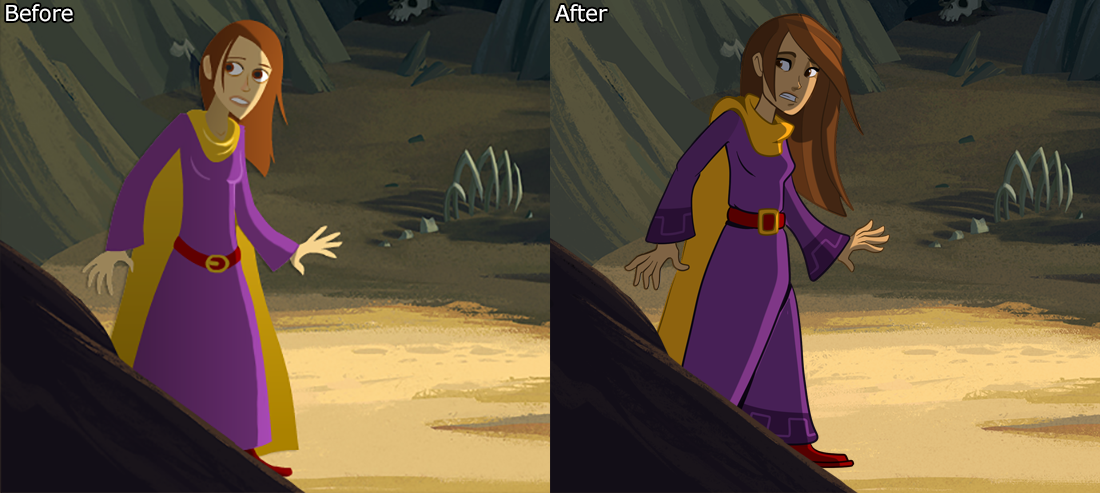
We did pretty well on the other bottlenecks -- localized into nine languages, available on Mac/Win/Linux, and we couldn't compete any more aggressively on price without abandoning sanity altogether -- we're priced at $14.99, often go on sale, and have been in two humble bundles.
Furthermore, our user satisfaction is through the roof:
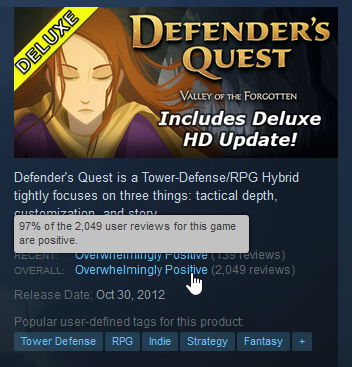
...and I've actually heard people other than my Mom call it "one of the best Tower Defense games of all time", so I don't think we're failing to appeal to fans of the genre.
So that, among other reasons, is why we released Defender's Quest DX as a free update. It also just seemed like a natural thing to do on the path to Defender's Quest II, since DQDX is simply the DQII engine with DQI's content. It makes sense to battle-test it now and fix all the bugs and other issues that crop up so DQII can be as rock-solid as possible.
Given that the old, unimproved version of Defender's Quest has sold well over 275,000 copies to date, I'm sure we haven't even come close to reaching the total number of people who are potentially interested in playing it.
My hope is that our bottle chart is starting to look more like this:
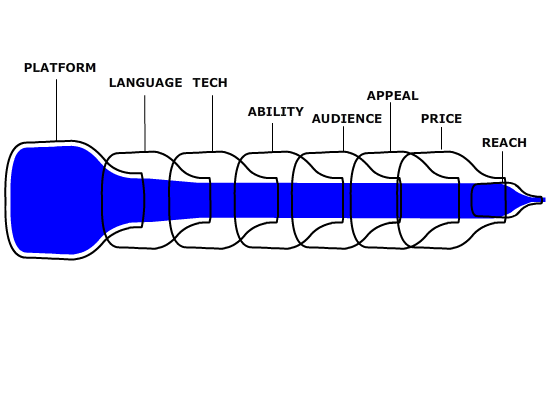
At which point, the only thing limiting us is how many people we can expose to the game. So, that's my theory, let's see if we can put it into practice.
Thoughts?